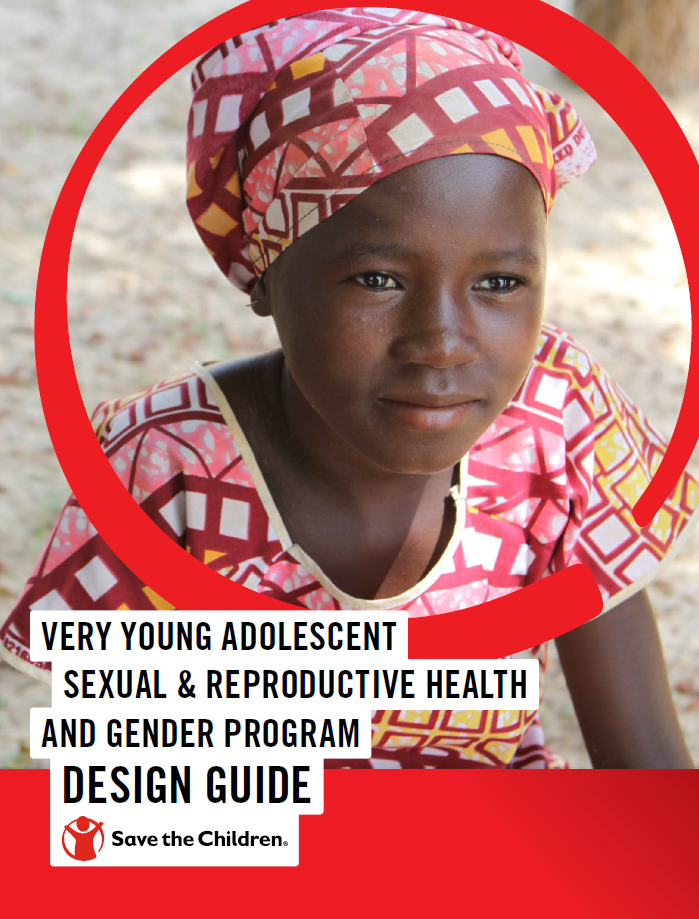Very Young Adolescent and Gender Program Design Guide
Adolescents are a large and growing portion of the world’s population. As of 2015, there were approximately 1.2 billion adolescents aged 10–19 in the world; of those, half were very young adolescents (VYAs) aged 10–14 years. VYAs are entering a unique life stage that includes one of the most intense periods of physical, intellectual and socio-emotional development in their lives. Many lack the knowledge and skills to deal with these rapid changes of puberty, and social norms prohibiting discussion of puberty, sexuality and related topics may further isolate them from the information and support they need. Emerging evidence indicates that VYAs often enter adolescence with very limited information about their changing bodies, their potential fertility or the challenges and advantages of adopting protective behaviors as they approach adulthood. Parents and guardians, an important source of guidance for VYAs, express feeling similarly ill-prepared to help their children understand and prepare for puberty.
In addition to the biological changes they experience, VYAs are also learning to navigate shifting societal expectations about their roles and rights. Recent findings from the Global Early Adolescent Study (GEAS) on VYAs from around the world reveal a remarkably consistent narrative about gender roles as children enter adolescence. Girls are portrayed as vulnerable, weak, and in need of protection from boys, who are characterized as dangerous and even violent predators. Girls are increasingly expected to remain in the home to be groomed for the duties of marriage and motherhood. Conversely, boys experience a new level of independence and freedom of mobility, but also heightened expectations to contribute financially to their families.
Given this reality, early adolescence offers a critical window of time to intervene with VYAs to improve gender and health outcomes. Until recently, they have largely been left out of global health initiatives – having survived their earliest years, they are generally healthy and considered to have few serious health risks. Most sexual and reproductive health (SRH) programs instead focus on adolescents and youth 15 years and older, many of whom have urgent health needs related to sex and contraception, early marriage and childbearing.
These programs, however, fail to capitalize on the protective power of prevention. Early intervention with VYAs can multiply health benefits and overall impact by helping adolescents and young people understand and avoid risky health behaviors and seek care proactively. This in turn can decrease adverse health outcomes during early adolescence and throughout the life course. Ensuring that VYAs have the opportunity to seek out comprehensive health information and services is also an important part of protecting their rights to health and well-being, as defined in the Convention on the Rights of the Child and agreements signed at the International Conference on Population and Development.
Save the Children’s Focus on Very Young Adolescents
Save the Children’s mission is to inspire breakthroughs for children and achieve immediate and lasting change in their lives to reach our vision of a world in which every child – that is, any individual under 18 years of age – attains the right to survival, protection, development and participation. Our child-centered approach emphasizes holistic care and prioritizes the most marginalized and vulnerable children. Working for and with VYAs, who are often overlooked by health and development programs, is a critical piece of achieving those goals.
Save the Children was one of the first international non-governmental organizations (NGOs) to prioritize and invest in VYAs. Over the years, we have worked to implement and continually improve our capacity and programming for VYAs, developing, refining, evaluating and adapting strategies geared towards this group’s specific needs, both in development and in humanitarian settings. In 2005, we launched our hallmark VYA program, Choices, one of
the first gender-transformative curricula for VYA. Since its successful pilot in Nepal, Save the Children has developed many additional programs to improve VYAs’ health, education and protection in countries across the world, including two complementary programs for Choices that now form a comprehensive approach for changing gendered attitudes, norms and behaviors: Choices, Voices, Promises (CVP). Similarly the Gender Roles, Equality and Transformation (GREAT) intervention package developed by Save the Children, the Institute for Reproductive Health and Pathfinder International, originally tested and evaluated in northern Uganda, has been adapted and scaled up in several locations around the world.
One adaptation of the package, called Growing Up GREAT, was implemented in urban Kinshasa and rigorously evaluated by the GEAS under the Passages Project. VYAs are a key demographic for our broader adolescent development (AD) work under sponsorship-funded programs in more than 13 countries across the globe. All of our internal guidance documents include considerations for VYAs’ unique needs, and many agency-funded programs feature activities and content specific to this age group.
